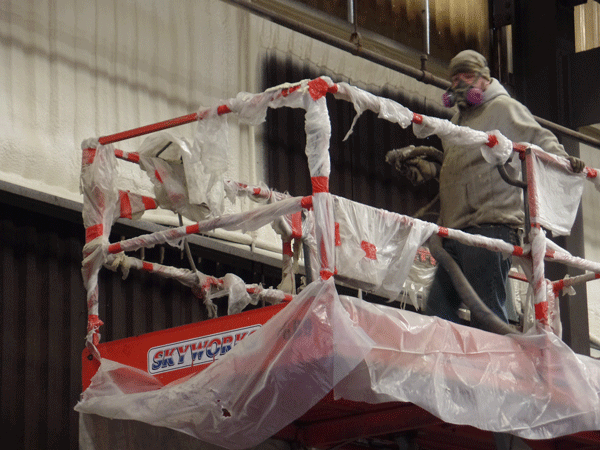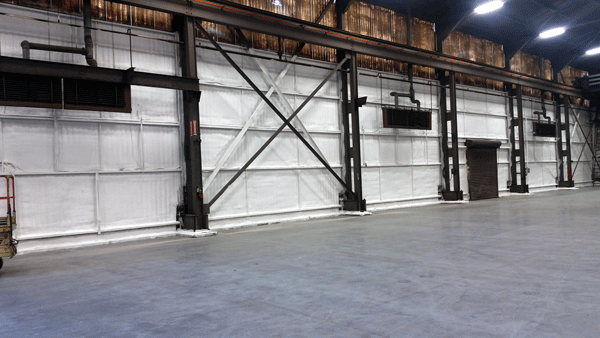Buckingham Properties has a lot of rental space: more than 8.5 million square feet (~789,700 m²) of rental space in the Rochester region of New York to be exact.
The company rents out high-tech manufacturing facilities, warehouses, specialized development complexes, small and large office buildings, medical office space, apartments and lofts, industrial parks, and large-scale land development.
One of its properties, an old large warehouse in Rochester, N. Y., was being leased to a nationally known manufacturer of pipe fittings that wanted to expand its operations into Rochester. The building was a perfect fit, but there was a problem: The building had metal walls that were not insulated and there was no functional heating system. That was not going to work, so the company looked into its options and ultimately settled on spray polyurethane foam (SPF), also referred to as spray foam, and intumescent coatings.
Buckingham Properties called on United Thermal Systems LLC, a Niagara Falls-based spray foam and roofing contractor, to get the job done.
Experience Wanted
The coatings company opened in 2011, and it has since grown from one to three crews with multiple spray foam and coating rigs “capable of handling any size project,” said Vice President Larry Ash.
“Many methods to insulate this building were explored and closed-cell spray foam was selected due to its high R-value properties and ability to seal all of the air gaps and holes in the metal panel sidewalls, reducing air infiltration,” Ash said. “United Thermal Systems was chosen to insulate this building due to our experience with insulating commercial and industrial buildings with spray foam and coatings.”
Ash said the client chose spray foam covered with a Flame Control intumescent thermal barrier coating “because it had been UL-tested and met all of the required criteria for use as a 15-minute protective coating. In addition, it was white and would provide a higher light reflectivity for the plant, reducing their lighting needs.”
Also part of the building upgrade: “The old asphalt floors were removed and a new radiant hot water flooring system was installed prior to a new concrete floor being poured,” Ash said. The bottom edges of the building had either deteriorated or been pushed outward by the former tenants, allowing snow to blow inside the building, he said. That wasn’t acceptable.
Getting Colder
The job involved applying spray foam and coating to 24,800 square feet (2,304.0 m²) of metal walls and girts. A crew of two men did the job, which took three weeks.

To start, the two-man crew removed dirt on the walls and girts using a high pressure air wand. Metal panels that had holes received patches, and loose seams received screws to tighten the panel seams prior to the spray foam and coating application.
Before they began spraying, they faced their biggest challenge, Ash said. It was frigidly cold outside — 25° F (-3.9° C) — and the work had to be done outdoors. There was no option to wait until spring, he said. “They had to have it done in the middle of the winter because the plant was being built to handle a customer moving into it,” he explained.
For that reason, the crew used Quadrant “Arctic” grade closed-cell spray foam. The crew put down 16,000 pounds (7,257.5 kg) of Quadrant “Arctic” grade 2-pound (0.9-kg) density closed-cell spray foam. They sprayed it with 2-inch (5.1 cm) thickness on the sidewalls and 1-inch (2.5 cm) thickness on all sidewall girts using Graco H-40 spray foam equipment.
The crew followed that up with 430 gallons (1627.7 L) of Flame Control 60-60A White Intumescent Thermal Barrier coating. The coating was spray applied using a Graco 45:1 coating pump and 200 feet (61.0 m) of coating line.
“Spraying foam and coatings in an unheated warehouse at 25 degrees presented a real challenge,” Ash said. “A special grade of [SPF] was used that allowed application in extreme cold conditions. New York state building code required a 15-minute thermal barrier coating over the [SPF], but that couldn’t be applied until 40° F [4.4° C] ambient temperatures were attained.”
That meant waiting.
Safety Precautions
While the crew waited, Spray Polyurethane Foam Alliance (SPFA) warning signs were posted every 15 feet (4.6 m) on the sidewalls, warning of the use of open flames and sparks until the new Thermal Barrier was applied. In addition, United Thermal Systems (UTS) held a special safety meeting with all on-site contractors to warn them of the hazards.
“The cold weather also created a material storage dilemma, and the materials had to be stored in a special ‘warm room’ to keep the materials from freezing,” Ash said.
Also needing to fight off the cold: Ash’s crew. “Our employees were supplied extreme cold weather work apparel,” he said. That included “Arctic clothing, gloves, hats, mittens — all that good stuff,” he said. They also made use of the “warm room” used to store the materials.
The crew needed to use a scissor lift, too, because the ground was uneven after the existing floor was removed. That meant wearing Miller harnesses and lanyards. North respirators were also used during the application process.
A Satisfied Customer
The client had given Ash and his crew a tight timeline. “[They] had to have production up and running by the end of the second quarter 2015,” he said.
But Ash and his crew were able to get the job done. “We ended up making it look good, so the customer was very happy with it,” he said. “The application turned out better than expected.”
The use of spray foam not only provided the needed insulation, it solved another problem, too, according to Ash. “It sealed the many holes and openings, providing an effective air barrier,” he said. “With radiant floor heat being utilized in this warehouse, spray foam insulation played a major factor in energy savings.”
At the end of the job, the owner of the warehouse was very pleased.
“We are amazed by the professional installation of the spray foam insulation and of UTS’s capabilities to complete the project in a short time span during the coldest winter Western New York had experienced in 50 years, allowing us to keep our construction schedule intact,” said Aaron Malbone with Buckingham Properties. “We couldn’t be happier with the completed final insulation project.”
